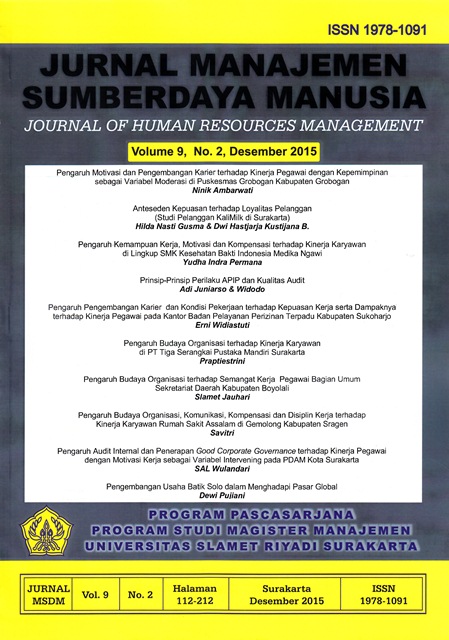ANTESEDEN KEPUASAN TERHADAP LOYALITAS PELANGGAN (Studi Pelanggan KaliMilk di Surakarta)
Abstract
The purpose of this study was to determine the effect of price, quality products, quality service, environment, and customer satisfaction on customer loyalty KaliMilk in Surakarta. The population in this study were individuals who had visited and buy products KaliMilk in Solo and intend to loyal. A sample of 160 respondents were taken by purposive sampling. The technique of collecting data using questionnaires. Hypothesis testing using analytical tools Generalized Structured Component Analysis (GSCA). The study concluded that (1) the price has no effect on customer satisfaction (2) the quality of the products have a significant effect on customer satisfaction (3) significant effect of service quality on customer satisfaction (4) significant environment effect on customer satisfaction (5) customer satisfaction have a significant effect on customer loyalty. This study can be used as a reference for practitioners in the decision to take steps to determine marketing strategies in order to improve quality, customer satisfaction, and establish customer loyalty KaliMilk. Keywords: price, product quality, service quality, environment, customer satisfaction, customer loyaltyDownloads
Published
2016-01-12
How to Cite
Dwi Hastjarja Kustijana B., H. N. G. &. (2016). ANTESEDEN KEPUASAN TERHADAP LOYALITAS PELANGGAN (Studi Pelanggan KaliMilk di Surakarta). JAMASADA: JURNAL MANAJEMEN SUMBER DAYA MANUSIA, 9(2). Retrieved from https://ejurnal.unisri.ac.id/index.php/Manajemen/article/view/1115
Issue
Section
Artikel
License
Authors who publish this journal agree to the following terms:
- Authors retain copyright and grant the journal right of first publication with the work simultaneously licensed under a Creative Commons Attribution License that allows others to share the work with an acknowledgement of the work's authorship and initial publication in this journal.
- Authors can separately make additional contractual arrangements for non-exclusive distribution published by the journal (e.g., publish it in a book), with an acknowledgement of its initial publication in this journal.
- Authors are allowed and encouraged to send their work via online (e.g., in the institutional repositories or their website) after published by the journal.













 Â
 
